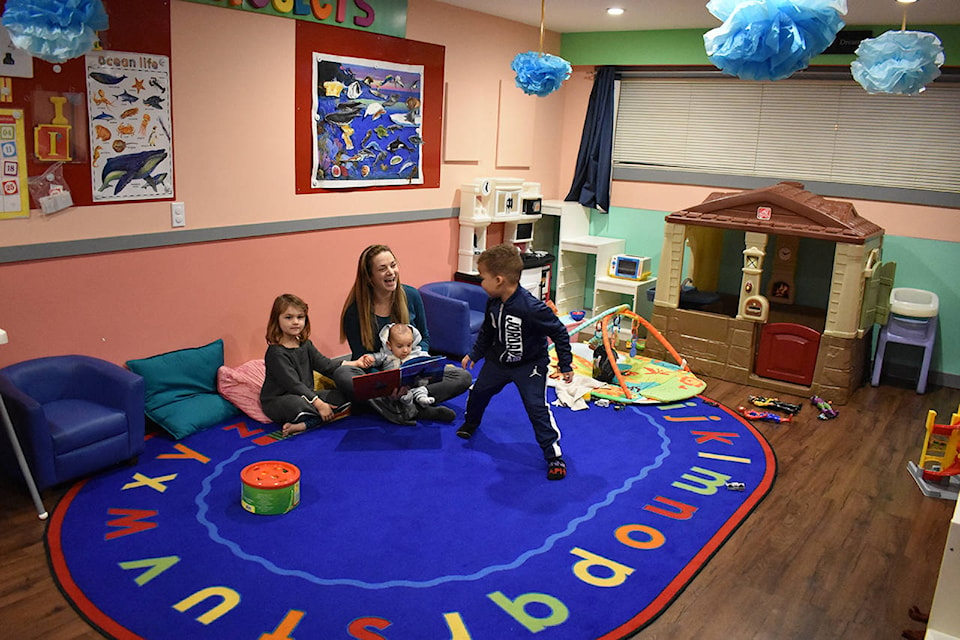Delta might have the highest proportion of government-funded daycare facilities south of the river, but both parents and child care providers are still experiencing significant difficulties when it comes to finding the right fit.
Take Nicholle Dhaliwal, a new mother and owner of North Delta Daycare.
She started her daycare in July 2015, growing it slowly by word of mouth. She is licensed to take care of eight kids each day, including three children under the age of three. Her own son, Midas, takes up one of those spots.
“I would be in a totally different position right now if I had him and I didn’t have my own daycare,” she said.
Of Dhaliwal’s eight daycare spots, she currently has one available — and she’s hoping to fill it with a kid who can come to the facility full time.
“It’s almost like Tetris, because basically I have up to 13 children enrolled,” she said about scheduling. Having a full-time child would prevent a shifting kaleidoscope of scheduling to fill that one space. And that, she said, is the problem for parents.
There are few spots available, she said, and the parents coming in are “inquiring for unrealistic spots.”
Although there is a shortage of available spaces, Delta has a relative abundance of facilities.
Delta is home to 20 per cent of all the ministry-funded child care facilities south of the Fraser. The only municipality with a higher percentage of funded facilities is Surrey, which has 34 per cent.
In addition, Delta has the third-highest proportion of ministry-funded daycare facilities to the number of kids in each municipality.
Delta has one ministry-funded child care facility for every 264 kids; the only two with a higher proportion are Aggasiz (one for every 213 kids) and Cultus Lake (one for every 19).
However, breaking it down by Delta’s communities shows significant differences in child care availability.
Overall in Delta, there is a child care spot for roughly one in every eight kids. However, in North Delta and Ladner that number is lower: one spot for every 10 kids. In Tsawwassen, there’s about one spot for every six kids.
Although North Delta and Ladner have an equal capacity for child care, there are significantly more facilities in North Delta. Those North Delta facilities, however, are typically much smaller than those in Ladner or Tsawwassen.
While the typical South Delta child care facility can manage 20 kids, North Delta facilities usually take eight. In fact, half of all South Delta facilities have a capacity of 20 kids or more, while less than a quarter of facilities in North Delta do.
But, Dhaliwal said, it’s not just about the number of spaces. It’s more often about when those spaces are available.
For Alysha Moore, psychiatric nurse and mother of two, that was the key challenge when she began looking for child care six and a half years ago.
“It’s been rough,” she said. When she first started looking for daycare options, she was working a casual shift and often on call. Now, she’s working in a permanent position, but has a schedule that changes every 24 weeks.
“We need somebody that’s willing to change with our schedule,” she said, which includes a 6:30 a.m. start time and necessitates before- and after-school care for her seven-year-old son.
After searching, Moore and her husband have found a nanny who comes to their home when needed. It averages out to the same amount of time each month, but some weeks the nanny is only needed for a few hours, while others she is needed for 50.
“It was difficult for a lot of childcare providers, because they either had certain days or times … or they wanted full-time hours,” Moore said.
Dhaliwal deals with that constantly.
“I feel bad, because at that point I have all these families that I think about, and they’re in limbo,” she said.
“Not all parents are working nine to five, Monday to Friday.”
In 2015, more than half of all employed Deltans worked either part time or a part year, according to the 2016 census. This appears to be an increase from 2010, when 37 of employed Deltans worked a part year, and a quarter put in part time hours. (The 2011 National Household Survey, where the 2010 numbers were taken from, does not have a combined part-year and part-time number.)
These numbers don’t show discrepancies in when individuals start work. In 2015, about 20 per cent of all employed residents left for work between 6 a.m. and 7 a.m., and a quarter left between 7 a.m. and 8 a.m. Around 29 per cent left between 9 a.m. and 5 a.m. the next morning in 2015, up from 22 per cent in 2010.
Although it’s not clear how many parents are part of the increase in atypical work schedules, such changes will likely continue to affect daycare facilities.
“We want to have more of our own children, but every time I have my own child, he takes up a space as well,” Dhaliwal said.
“Which is okay, but, you know,” she laughed. “He’s a little too young to pay his way.”
grace.kennedy@northdeltareporter.com
Like us on Facebook and follow us on Twitter
